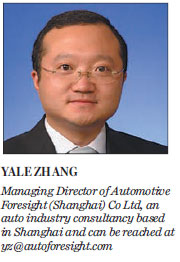The cost ineffectiveness of NEVs for urban buyers
China's new-energy vehicle market is being driven by policy. According to the central government in late 2013, 88 cities are expected to get 335,000 such vehicles on the road by the end of this year.
Yet, even now, more than half of those cities are not being proactive enough and have no concrete measures to subsidize consumers to make those purchases happen.
As opposed to the first phase of the pilot project, which ran from 2010 to 2012 and saw 25 first- and second-tier cities expected to hit a 1,000 vehicle target, the second phase features small third- and fourth-tier cities, which aim to have 5,000 to 10,000 new-energy vehicles respectively by the end of this year.
Residents of these smaller cities have lower incomes and most likely do not feel it is feasible to buy a new-energy car even with the subsidies. More importantly, these cities do not have tight restrictions on car registrations, such as in the metropolises of Beijing, Shanghai and Guangzhou, so there is no incentive for someone to buy a new-energy vehicle just to obtain a car license.
Global customers purchase new-energy vehicles based on practical interests and convenience; few will consider only the concept of environmental protection. Chinese customers, however, will impart less importance on environmental protection. They are mostly influenced by better fuel efficiency, large subsidies, tax reductions and hassle-free car registration.
When the price of a new-energy car is twice that of a tradition vehicle, even after the subsidy, and while the driving range is only 150 to 200 kilometers on one charge, consumers will not feel guilty about rejecting "green" vehicles.
Looking at the sales data we can see that most are being sold in large coastal cities. Interestingly, a survey in China by AutoForesight found that more than 60 percent of respondents in smaller, inland cities were "very interested" in new-energy vehicles, compared with less than 50 percent in second-tier cities, and less than 35 percent in first-tier cities.
The results largely come down to the lower passenger vehicle penetration in undeveloped areas, as people here have less experience owning vehicles, so are more easily attracted by new technology.
Suburban customers in small cities have courtyards, so charging batteries can be done right in their backyard, and low-speed new-energy vehicles do not need to be registered with the police in smaller cities. Ironically, consumers in large cities are less interested in new-energy, but because of stringent car license registration controls, a new-energy vehicle is often the easiest way, if not the only way, to buy a car.
Subsidies are a second temptation. When subsidies are phased out by 2019, a free car plate and no traffic controls over NEVs look like the most powerful incentives for individuals in large cities. Therefore, the biggest demand for new-energy vehicles in small cities might come from institutional buyers: new-energy buses, taxis and municipal vehicles such as sanitation trucks. However, these small cities are not strongly motivated to buy 5,000 to 10,000 expensive new-energy vehicles.
Focus on public vehicles
In the first phase of the pilot project, those 25 cities hit their 1,000-unit target mostly at the end of 2012. This time, the target is much higher, so bus and taxi fleets in small cities will have to make a greater contribution to these cities' environmental protection campaigns.
The number of urban buses in China has been increasing steadily due to urbanization, roughly by 4.4 percent annually - 20,000 to 25,000 - since 2007. By the end of 2013, there were 446,604 buses on the road.
Total demand for new buses is about 60,000 a year in the foreseeable future, and according to the Ministry of Transportation, at least half of these should be new-energy vehicles.
There were just over 1 million taxis on the road by the end of 2013, with an average annual increase of 1.6 percent. The average annual demand for taxis nationwide over the next few years is expected to be 180,000 to 200,000 units a year. However, in most Chinese cities, taxis belong to individuals rather than State-owned taxi companies. When local governments give orders to taxi drivers to change their cars to new-energy ones, the response will likely be slow.
By the end of 2013, there were 126,552 sanitation vehicles. Annually, the total number is increasing by 10 percent, with the average annual demand forecast to exceed 20,000 units, among which the demand of new-energy vehicles is expected to be 10 to 15 percent because of limited budgets.
There are other discussions that logistics companies in cities should be the ideal target customers for new-energy trucks.
This is a sound plan, but it's simply an ideal. Nearly a million light trucks are sold in China every year and used for short-distance or urban journeys, but these trucks are mostly owned by individuals. Mainstream truck models are low-end products, usually priced at 50,000 yuan ($7,800) to 60,000 yuan.
High-end light trucks sell for 100,000 yuan.
It's unimaginable for those truck owners to replace their current vehicle for some 500,000 yuan new-energy truck with limited driving range unless the government wants to subsidize 80 percent of the price.
Indeed, we have heard a lot about new-energy vehicle sales to fleet customers repeatedly in the past. However, when we dive deeper, the truth is that the sales figures are not impressive.
Buses and taxis may be the most important fleet buyers now and in the future, but the overall volume is still limited.
Individual demand is the only hope for the new-energy vehicle market and carmakers have no choice but to lower their new-energy vehicle costs to reasonable levels.
Although car license restrictions could effectively force many individuals to consider buying a new-energy vehicle in major cities, automakers should respect individual consumers by offering good new-energy vehicle products because these big-city consumers are well-informed, experienced and particular about quality.

(China Daily 09/28/2015 page18)














